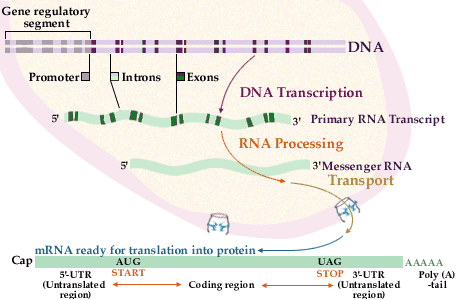 |
The GeneA functional and inheritable element in the genome is referred to as a gene and usually codes for a protein. In some cases genes also code for RNA molecules that are not translated to protein, e.g. ribosomal RNA. The protein coding sequence of
most genes is interrupted many times by blocks of
noncoding sequence, these are called introns while
the blocks of coding sequence are called exons.
Introns are removed by a process called
splicing. The promoter is an important functional segment of the gene. This is where the RNA polymerase binds to initiate transcription, i.e. the synthesis of an RNA molecule which is a copy of the DNA sequence. The initiation of transcription is a highly regulated process. Only a few percent of the genes in each cell are transcribed, and most of those genes are transcribed at a very low frequency while a small subset of genes coding for highly abundant proteins are transcribed at a high frequency. The gene regulatory segment, of which the proximal part is referred to as the promoter, usually consists of many different DNA segments defined by their particular base pair sequences. Each individual segment, usually involving about 6-12 base pairs of DNA, serves as a binding target for a DNA binding protein which functions as a transcription factor. One gene regulatory segment may contain binding sites for a large set of different transcription factors, five-ten or more. These different transcription factors often have their binding targets dispersed over a wide area within the gene regulatory element which may involve DNA segments several thousand base pairs upstream and/or downstream of the promoter and which may be located within the transcribed gene, e.g. in an intron. Each cell type usually has a set of celltype specific transcription factors and in addition some other basal transcription factors that are more or less common to a large set of genes in many different cell types. Each of these transcription factors also form complexes with other proteins thereby targeting various other proteins to a particular set of genes. Furthermore, the DNA binding capacity of various transcription factors is usually regulated via cellular signals through extracellular hormones and receptor pathways or via cell interactions with the environment. In this way a particular stimulus in the surrounding of a cell will trigger the binding of a set of transcription factors to a certain set of genes, thereby adapting the activity of this cell to the new situation which gave rise to the signalling. In this way various gene regulatory networks in all multicellular organisms, humans being one of them, are constantly adjusted to fullfil the requirements of the environment and the needs of the organism itself. |